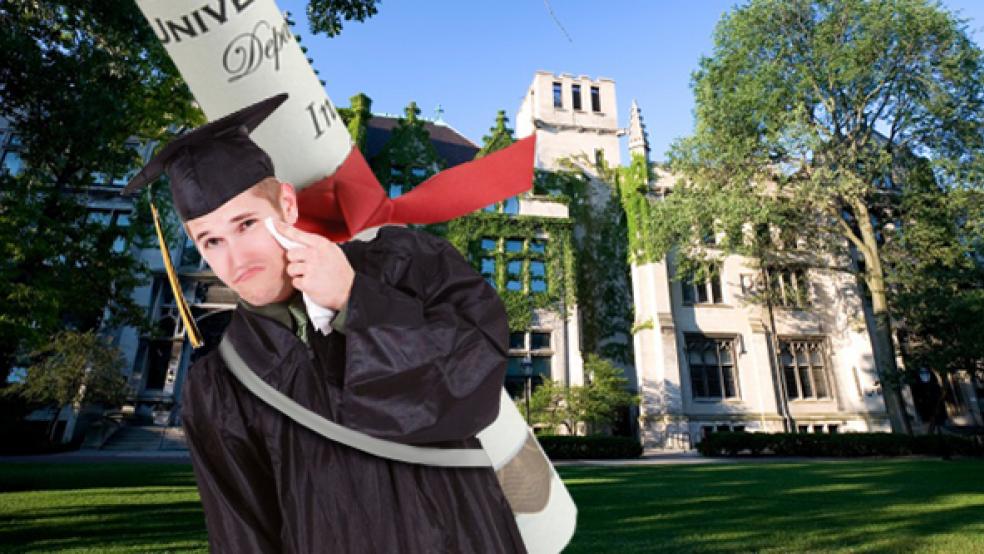Shayna Moreno, 23, graduated in May, 2012 from a private university in California with $100,000 in loans -- a daunting amount, given that as an entry-level public relations account coordinator, she makes only $32,000 per year. The loans include $20,000 in federal loans, and another $80,000 in private loans and Parent Plus loans, which she’s helping her parents pay. Under the original terms of the loans, she would have owed almost $1,000 per month on the debt.
Moreno was able to reduce her monthly burden slightly by consolidating her federal loans into a graduated payment plan, under which she pays just $180 per month, instead of the $305 originally owed under the standard repayments plan. However, those payments are just chipping away at the loan’s 7.9 percent interest without reducing principle on the loan, which means in the long-term the loans are going to cost her even more.
Every two years the monthly amount Moreno owes on the federal loans will increase. “I know it may take a little longer to pay them off, but at least I can chip slowly away at them,” Moreno says.
Americans currently owe a record $1.1 trillion in student loan debt, second only to mortgages in household debt, according to the Consumer Financial Protection Bureau. According to a March, 2011 report by the Institute for Higher Education Policy, two out of five student loan borrowers fall behind on payments.
But there are options to make loans more manageable. If you’re having trouble meeting your student debt obligations, take these steps to reduce your monthly payments.
1. Explore Alternative Federal Repayment Programs
Borrowers have to petition for these alternatives, calling the loan servicer to request a switch. Here’s a breakdown of the options:
- Graduated repayment: progressively increases the monthly payment over 10 years.
- Extended repayment: Stretches the loan out over a 25-year period
- Income-based repayment: Payments are capped at 15 percent of your income for up to 25 years.
- Pay-As-You-Earn: Caps monthly payments at 10 percent of your monthly income for up to 20 years. (This option is only available for those can prove financial hardship and who took out loans after October 1, 2011)
For all of these options, even though monthly payments will be lower, the total interest paid will be higher, making the loans more expensive in the long run.
BANKRUPT AT 21: TRAPPED IN A WEB OF STUDENT LOANS
Students may also be eligible for deferment and forbearance, postponing payment of their loans if they're in school or are unemployed. Though this is a better alternative than defaulting on loans, it shouldn't be considered a long-term solution since interest still accrues, says Jeff Webster, assistant vice president of research and analytical services for Texas Guaranteed Student Loan Corp. "It's meant to get you through a tough spot, but if you're leaning on that, you will end up owing a whole lot of money," he says.
Decide which option is right for you by assessing whether your financial difficulty is short- or long-term, says Mark Kantrowitz, publisher of Edvisors.com, a network of Web sites on college admissions and financial aid. If you're unemployed but expect to get a job, deferment or forbearance could be appropriate, but if you have a job in a low-paying field, income-based repayment may be a better option.
2. See if you qualify for public service loan forgiveness
Those who work in the government, military, or non-profit sector may be eligible for Public Service Loan Forgiveness, if they use an alternative payment plan, and have an outstanding balance after 10 years of on-time payments. “It’s not unusual to make payments for 10 years and still owe a lot," says student loan expert Heather Jarvis.
3. Contact your private lender about repayment options
Private loans generally have a standard repayment plan with less flexibility, but sometimes lenders will work with borrowers facing financial difficulties to create some type of reduced monthly payment, says Lori Moore, financial literacy program director for Access Group, which owns a large portfolio of student loans.
She suggests it's often better to repay private loans first because of the flexibility offered under the federal plans, though if a student has a very low interest rate with a private loan and has a steady income, there may be an advantage to paying off federal loans first.
RELATED: HOW GOVERNMENT STUDENT LOANS RUINED COLLEGE EDUCATION
4. Make it automatic
Loans received under the Federal Direct Lending Program are eligible for a .25 percent rate reduction if borrower enrolls in an auto-pay system, which automatically deducts the monthly payment from the borrower’s bank account. Webster recommends participating, since it minimizes the chance you’ll miss a payment. Some private lenders may provide interest rate discounts for auto-pay as well.
5. Consolidate, where possible
Paying several different loans can be difficult administratively, says Peter Mazareus, founder of Invite Education, a college planning site. Federal and private loans cannot be consolidated under one loan, but multiple federal loans can be consolidated into one loan, and multiple private loans can be consolidated as well. However, if some of the loans have a low interest rate and consolidating them will increase the overall rate, it may not be the best option. Instead, keep the loans separate and pay down the highest-interest loan first.

